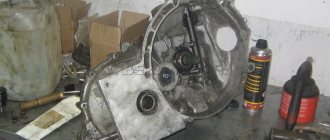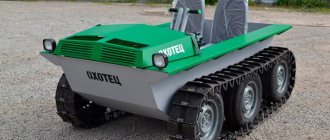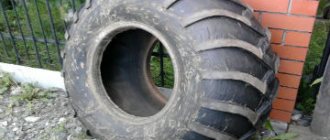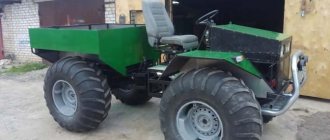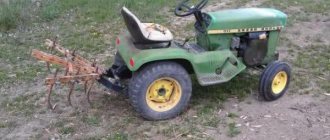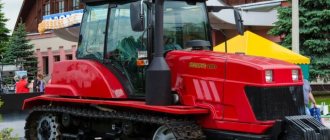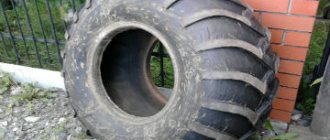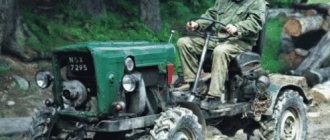Published:
21.06.2016
In rural areas, a common problem is the lack of roads. This problem is especially acute during winter, when even the usual crossings are covered with a layer of snow. To improve traffic even during such a period, you can make an all-terrain vehicle out of the Oka car on your own.
Do-it-yourself Oka all-terrain vehicle
The Oka car is a famous creation of the AvtoVAZ plant. It gained popularity for its low fuel consumption and miniature size. Currently, production of the machine has ceased. Many current owners, regardless of their skills, are trying to improve their vehicles by improving many units and mechanisms. They are also experimenting on Oka. Some have created a real all-terrain vehicle out of a car.
Examples of an all-terrain vehicle from Oka
There are a wide variety of examples. Sometimes the imagination of developers and designers is amazing. They make such unimaginable models of all-terrain vehicles from the Oka River that it’s hard to believe. As a rule, such alterations differ only in design, wheel size and type of chassis. Most often, all-terrain vehicles are made on the basis of low-pressure tires for good cross-country ability.
The chassis of other vehicles is taken as the basis for such cars. The wings are cut off for ease of installation and installation of wheels. There are all-terrain vehicles in which the body part is also modified. Most often this gives an attractive appearance. Some craftsmen also manage to beautifully straighten and paint the joints of the body parts.
In this photo, the car enthusiast also installed protection for the bottom of the car. This is done in order to reduce the load. If the owner would repaint the entire vehicle, he would get an excellent and high-quality all-terrain vehicle.
There are designers who also try to improve the strong qualities of the car. Since the engine on Oka’s car is weak, they are installing engines from other vehicles. This process is labor-intensive, but people come to it for the sake of a few horses. Some car enthusiasts pay great attention to the body and appearance. Sometimes you get such models that it’s not a shame to show them at some exhibition.
Tracked all-terrain vehicle from Oka: design features
Making an all-terrain vehicle based on tracks is a complex and expensive process. Of course, you can build them yourself, but it’s best not to overthink anything and buy ready-made ones. An excellent option would be tracks from Buran. They are much cheaper and have sufficient mass.
Drive shafts also need to be purchased from this model. The Oka variable gearbox with brake mechanism will be ideally combined with such tracks. The splined part of the drive shafts must be removed and mounted with the Oka. This is where the car's own CV joints come in handy. Brake discs are also convenient to attach and connect to mechanisms. The same work must be done on the front shafts. After this procedure, it is necessary to install the brake mechanisms. It is best to install the brakes at the front.
Next, you need to check the operation of all mechanisms and their fastenings. If everything works flawlessly, then we can safely start using such an all-terrain vehicle. You can also find models in which tracks are installed on each wheel. The only advantage of such a vehicle is considered to be less weight. However, traction will be better with solid tracks.
How to convert an eye into an all-terrain vehicle with your own hands
If you decide to independently improve your Oka car, then initially you need to prepare. For production you will need:
- Oka car;
- profile pipe for frame;
- chassis from Niva;
- VAZ-1111 engine;
- steering from "Nine";
- tires.
First you need to make a frame from a profile pipe. It is best to develop a detailed diagram and contact a professional welder to ensure reliable connections. After this, the transfer case is installed and connected to the vehicle’s mechanisms. As for the suspension, it is best to install springs here. There can also be springs, but then the frame design will become more complicated. And in general, springs will be better for off-road driving. To install the wheels, it was necessary to cut off the car's fenders. If this is not done, it will be impossible to install large diameter tires. The Niva chassis should provide ideal off-road performance. Once the basic assembly is completed, the vehicle needs to be inspected. It is best to carry out tests at once in several stages off-road.
SUV from Oka: what to watch out for
As practice shows, the all-terrain vehicle also has weaknesses and vulnerabilities. Engine oil consumption increases, especially if you often overcome water obstacles. Some owners of such all-terrain vehicles note rapid wear of the rubber. There shouldn't be any problems with the frame, but it's best to play it safe and double-check the welds. It is best to cover all mechanisms and parts with protective material or paint to avoid corrosion. Due to sloppy connections, water can get inside the car, which will soon cause a problem.
It is necessary to additionally install special protection on the engine sump. Some car enthusiasts specifically attach foam to increase the buoyancy of the vehicle. If the designer decided to leave springs instead of springs, then there is a high risk of their rapid wear. It causes roughness and discomfort for passengers while driving off-road.
In conclusion
It is difficult to imagine that Oka can act as an all-terrain vehicle. Nevertheless, ingenuity and resourcefulness make it possible to create a real off-road conqueror out of this “baby”. Full-fledged Russian-made SUVs, not to mention foreign-made grandees, are very expensive. Converting a “compact car” into an all-terrain vehicle also requires considerable expenses. However, many consumers are confident that “the game is worth the candle.” First, the transformation can be carried out in stages. Secondly, you can easily find spare parts, as well as use improvised means and parts from non-working cars.
Among the most popular homemade versions of the all-terrain Oka, Fr. They are based on low-pressure pneumatic wheels. The originality of the tracked models is that they are perfect for snowy and sandy areas.
A fairly simple and cheap to assemble all-terrain vehicle based on the Oka was made by Leonid from the city of Nyagan. The all-terrain vehicle is capable of reaching a speed of about 50 kilometers per hour, and can also overcome water obstacles by swimming. the car was made mainly for forays into remote areas of the forest for gathering.
To assemble such an all-terrain vehicle, the following parts and materials were required:
1) Body from an Oka car 2) profile pipe for frame assembly 3) VAZ 1111 internal combustion engine 4) most of the chassis from Niva 2121 5) SHAIN tires 6) Steering gear from VAZ 2109
Let's take a closer look at the work done on the all-terrain vehicle.
To begin with, the author decided to make the frame of the future all-terrain vehicle. the frame was made independently from a profile pipe available from the author.
The frame manufacturing diagram is shown below:
This is what the front axle of the assembled all-terrain vehicle looks like:
The fastenings from the Muscovite bridge were cut off to install springs. Springs from the Muscovite 412 with stepladders were installed; for this purpose they were pre-sized and overcooked. Initially, the author planned to make a spring suspension, as is customary to do on all-terrain vehicles with a small mass of the Oka type, but decided that springs were still more reliable, since for springs it was necessary to complicate the frame to accommodate the travel of the springs and install more salen blocks for fastening. That is, the main factor in favor of spring suspension was simplicity and reliability.
After the main assembly, the author began testing the car. As the tests progress, minor improvements are also being made, in particular, deficiencies are identified and eliminated, work continues on the appearance of the vehicle, and the suspension system is being improved.
The weight of the all-terrain vehicle was about 800 kilograms. The all-terrain vehicle has the following dimensions: base length 210 centimeters, width 208 centimeters, length of the entire all-terrain vehicle 360 centimeters, height is about two meters, ground clearance is 40 centimeters.
Painting work was carried out, and foam was installed under the bottom for greater buoyancy:
For the same purpose, a camera can be attached to two straps in the front of the all-terrain vehicle; with this approach, you don’t have to worry about the stability of the vehicle on the water.
Do-it-yourself tracked all-terrain vehicle with an Oka engine
- home
- Feedback
Popular
Homemade muesli with your own hands
Sandwiches with tomatoes: step-by-step recipe with photos Sandwiches with cheese baked with mayonnaise
Black beans: benefits, recipes, cooking secrets Black bean recipe
Flash point of vegetable oil
Letter for refund: sample
Sunflower oil (refined)
Lenten chocolate muffin with cranberries in a slow cooker
Do-it-yourself caterpillar all-terrain vehicle made of oka. How to make an all-terrain vehicle from the Oka with your own hands? Snowmobile with Oka engine drawings
Homemade all-terrain vehicle on caterpillar tracks, made from Oka.
The Oka compact car is not the best option for the village; in off-road conditions, to travel on country roads, you need a good SUV.
One craftsman solved this problem in a rather original way; he made his Oka into a powerful homemade all-terrain vehicle on caterpillar tracks. We invite you to familiarize yourself with the process of building an all-terrain vehicle shown in the photo.
And here are the mounting points for the engine and suspension of the all-terrain vehicle.
I made an all-terrain vehicle frame from profile pipes.
I started making suspension on balance beams with torsion bars.
Rollers for tracks and drive stars were made from wheel rims.
Then, the Oka body was installed on a homemade frame.
I would like to clarify that the tracks are taken from a snowmobile.
And this is what the interior of the all-terrain vehicle looks like, instead of a steering wheel there are track control pedals, brakes are installed on the leading track stars, turning is carried out by braking one of the tracks.
This is how the all-terrain vehicle from Oka turned out, on caterpillar tracks. The homemade vehicle reaches a speed of 30 - 40 km/h and can easily move through snow and mud. You can additionally install a blade and clear snow in winter. The all-terrain vehicle can tow a light trailer or pull out a stuck car. In general, an excellent homemade product for a villager.
All-terrain vehicle from Oka, built with your own hands: drawings, photos and description.
This all-terrain vehicle is built on the basis of the Oka compact car. We invite you to take a look and get acquainted with the design of the homemade product.
Wheels or tracks
Do-it-yourself Karakat with a VAZ engine
Before developing drawings, you should decide on the concept of the chassis of the future homemade product:
- The low-pressure tire design is based on axles mounted on leaf springs and additional hydraulic shock absorbers. The closed body is placed on brackets that allow the use of large diameter tires. The equipment is lightweight and can move through deep snow and marshy areas. To reduce weight, it is possible to build an all-terrain vehicle on stripped tires - tires from agricultural machinery with a partially removed tread and cut out steel cord.
- A do-it-yourself tracked all-terrain vehicle from Oka is built on the basis of a chassis with rubber bands and road wheels made of wheels with rubber tires. The equipment can move on loose soil and ford water obstacles. The vehicle weighs more than the basic Oka passenger car; due to the use of a tracked propulsion system, it requires the installation of control levers connected to the on-board brakes to turn the all-terrain vehicle.
How to make an all-terrain vehicle from Oka and what is needed for this?
- Design Features
- Assembly steps
- Spare parts and materials
Small cars are the butt of many people's jokes. However, they are suitable not only in their original form, but also as a basis for independent technical research. You just need to know, for example, how to make an all-terrain vehicle from the Oka and what is needed for this.
Design Features
Making a homemade all-terrain vehicle from Oka is attractive simply because it is more profitable than many officially produced designs. Not only brand new cars, but also cars that have been broken or have been in an accident are suitable as a basis. Many hobbyists create real “universal” all-terrain vehicles that ride on low-pressure tires. Some models are equipped with air cushions.
Tracked vehicles can also be made with your own hands, but this solution is more likely to be suitable for driving on snow, and in the summer months its advantages are, to put it mildly, not obvious.
But everything changes - you just have to go to rough, and especially swampy or heavily humid terrain. There the caterpillars will convincingly demonstrate their superiority. There is no need to buy expensive components. It is worth considering that in wheeled versions all movers are leading. It is useful to use “breaking” frames, which are much more practical than rigid analogues.
Returning to tracked all-terrain vehicles, it should be emphasized that they are especially good for hunters, gamekeepers and fishing enthusiasts . This technique will, of course, be pleasant for connoisseurs of extreme tourism. Most often, the length of the vehicle does not exceed 3 m, because otherwise the cross-country ability is reduced. And there will be more difficulties in manufacturing. In any case, you will have to carry out careful calculations and prepare detailed drawings.
Assembly steps
Making an all-terrain vehicle with your own hands begins with finding a suitable base . A common solution is to use motorcycle frames. The specific brand does not play a special role. It is much more important to take into account the financial side of the matter and the passability of the finished structure. If you need to conquer the most severe off-road conditions, the base frame is taken from Izh motorcycles, and the engine and control system are mostly left from the car.
At the next stage, you need to make a connection between the suspension and the rear axle. Most often it is formed from a strut that tightens the spar parts. By adding a strut and handlebar bushing, an independent type rear suspension will be formed.
This solution guarantees excellent maneuverability even on difficult routes. When this is done, you need to install the wheels.
Most often, all-terrain vehicles based on the Oka are equipped not with wheels in the full sense of the word, but with cameras from trucks . Hubs are used to secure the suspension. The stability of the structure is guaranteed by special tapes wound on the outside. Practice shows that such projects are quite reliable and successfully overcome various obstacles. The next step is fixing the engine and installing mechanisms that transmit torque.
We will also have to install brakes, a clutch and an exhaust system. When all the main work is completed, the all-terrain vehicle must be tested. Experts emphasize that errors in its manufacture often make the device dangerous for the riders themselves and other people. It is worth understanding that even the “simplest” transport cannot be done properly if the drawings are not prepared. The scheme of operation differs slightly depending on the execution of a particular sample.
Thus, making a vehicle on tracks with an Oka engine is possible only with careful consideration of the dimensions of all components. There are much fewer “degrees of freedom” here than when working with wheeled vehicles. The engine is removed along with the gearbox, because using dissimilar units is too problematic.
Then the frame of a tracked all-terrain vehicle is made based on a profile pipe. You can get the suspension from balancers with torsion bars.
Recommendation: for models designed for off-road use, the “native” power plant is not powerful enough. We'll have to take more serious models from cars with more power. The caterpillar rollers and “stars” are installed independently. Sometimes only the body of the Oka is left. It and all the main components are installed on a self-made frame.
It is also useful to consider how a 4x4 with an Oka engine is made. The wipers, pedal assembly, brakes, calipers, exhaust pipes are also removed from it. The entire frame is made from scratch using a suitable tubular profile. The next step is the installation of bridges and main components. First of all, you need to place the steering column among them; after that, the “kung” is made and assembled, and the car is sheathed.
If the Lenekhod model is taken as a basis, then the transfer case needs to be fixed to the mounts from the Moskvich bridge, which usually hold the springs . These fasteners are measured and welded. On weak all-terrain vehicles you can make spring suspensions. However, springs are much more reliable and eliminate the need to modify the frame or add silent blocks.
Recommendation: regardless of the selected sample, sea trials should be immediately carried out and any deficiencies found should be immediately corrected.
Spare parts and materials
The design of a “breakable” all-terrain vehicle based on the Oka engine, pedals, and brakes also includes:
fist from the bridge of the Ulyanovsk car;
tubular profile 50x20, 40x20;
steering wheels from UAZ (they don’t use hydraulics);
custom-ordered windshield;
radiators from Toyota;
winch for self-pulling.
An alternative selection of components is presented:
also the engine and gearbox of the Oka car;
propulsors from a KrAZ truck;
taxiing system and springs from GAZ-21;
sheet steel of suitable thickness;
square tubular profile;
Important: the springs of the Volga cannot be changed; they must contain the same number of sheets as on the factory copy. The differential needs to be welded.
The “grenade” taken from the “Oka” is cut off and a flange corresponding to the Niva’s cardan is welded onto it. The standard steering wheel from the GAZ-21 is very difficult to control - it is better to immediately install power steering. It is better to take wheel rims with an offset, then the wheels will be removed from the body, the turning radius on the front axle will increase.
The tires are taken from a KrAZ truck. To peel them off and bring them into optimal shape, you will need a chainsaw and an electric hoist. Additional trimming is done with a utility knife. In addition to the tools already mentioned, you will need:
metal files;
welding machine and certain accessories.
The already mentioned “Lonekhod” is assembled on the basis of:
the car body and its “native” engine;
frames made of profile pipes;
the main part of the chassis from the VAZ 2121 (the rest is made by ourselves);
steering controls from VAZ 2109.
For information on where to start building an all-terrain vehicle from the Oka, see below.
Let's start making a tractor
So, let's start by making the frame. To make a tractor with your own hands, you need two spars - left and right. You will also need two traverses (front and rear). For the manufacture of spars, you need to use channel No. 10. For traverses, channel No. 12, No. 16 is suitable. According to the diagram given in the article, you need to connect all the parts.
As for the engine, ideally, of course, choose a diesel one. Such engines have much higher torque than gasoline engines. If you plan to make a tractor with all-wheel drive, you will need to increase the gear ratio on the gearbox pairs. But if a diesel engine is not available, it is possible to install a unit from an Oka car.
The front axle from Oka is installed on the frame without changes and is secured to it at four points. In principle, you can install a driveshaft from any rear-wheel drive car, for example, a VAZ-2101.
Swamp walkers from a walk-behind tractor
Self-made swamp vehicles, in their principle of operation and design, completely repeat the design of a snowmobile. Both have the same principle - to reduce the pressure on the surface on which the unit will move. To create a swamp vehicle, it is important to select or make wheels or tracks yourself - the width should be much larger than the standard.
To create a motor-block snow and swamp-going vehicle, follow the approximate plan:
- Strengthening the frame or rebuilding it is carried out by installing additional pipes.
- The motor and steering wheel are placed on the frame.
- The chassis and front sprockets are also installed here.
- An intermediate shaft with rubber linings is installed.
For the undercarriage, you can use tires or tracks. Each option is special in its own way, and all the characteristics for creating a tracked and wheeled unit are described above.
Stages of creation
To acquire the design of an SUV, you will need to carry out the following manipulations:
- Finding the basis for the vehicle. Using a motorcycle frame is quite suitable for this. The brand doesn’t matter, it all depends on the financial choice, as well as off-road preferences. This indicator is most developed in IZH motor vehicles.
- Creation of the rear axle and suspension. To do this, you need to use a strut that connects the side members. All this is complemented by a strut and steering bushing, which as a whole form an independent rear suspension. It is recommended to use just such a suspension, because it will provide the product with the necessary maneuverability in difficult places.
- Installation of wheels. In practice, such an all-terrain vehicle based on the Oka is equipped not with the wheels themselves, but with their cameras. They are taken from trucks and attached to the suspension using a hub. Stability is complemented by special tapes that wrap around the wheel. As a rule, cameras from KAMAZ, Ural and cargo trailers are used. This solution increases the reliability of the trip.
- Providing torque and mounting the engine. Such procedures begin to be done after installing the frame and suspension. In addition to the motor, you will also need to install a brake, clutch and exhaust system.
When the entire list of work has been completed, it is necessary to test the device for functionality. If errors are identified, they must be corrected. As practice shows, an illiterately made all-terrain vehicle or swamp vehicle from the Oka can create a danger to others.
How to strip off old tires
It is also possible to use recycled tires instead of a rubber protective layer on top. It’s no secret to many that there is a way to peel off old tires (see the video of the process below) in order to lighten the future wheels of an all-terrain vehicle and protect them from punctures. But it’s not easy to peel them off; you need to use some technique and proper processes. I think there is no point in describing exactly how to peel off the wheels of an all-terrain vehicle in a simple way, watch the video and you will understand everything yourself
So, here's a video of how this process happens.
Stages of creation
To acquire the design of an SUV, you will need to carry out the following manipulations:
- Finding the basis for the vehicle. Using a motorcycle frame is quite suitable for this. The brand doesn’t matter, it all depends on the financial choice, as well as off-road preferences. This indicator is most developed in IZH motor vehicles.
- Creation of the rear axle and suspension. To do this, you need to use a strut that connects the side members. All this is complemented by a strut and steering bushing, which as a whole form an independent rear suspension. It is recommended to use just such a suspension, because it will provide the product with the necessary maneuverability in difficult places.
- Installation of wheels. In practice, such an all-terrain vehicle based on the Oka is equipped not with the wheels themselves, but with their cameras. They are taken from trucks and attached to the suspension using a hub. Stability is complemented by special tapes that wrap around the wheel. As a rule, cameras from KAMAZ, Ural and cargo trailers are used. This solution increases the reliability of the trip.
- Providing torque and mounting the engine. Such procedures begin to be done after installing the frame and suspension. In addition to the motor, you will also need to install a brake, clutch and exhaust system.
When the entire list of work has been completed, it is necessary to test the device for functionality. If errors are identified, they must be corrected. As practice shows, an illiterately made all-terrain vehicle or swamp vehicle from the Oka can create a danger to others.
Possible nuances
Despite its advantages, this technique has its drawbacks. Frequent troubles are caused by the fragility of low-pressure chambers. Of course, due to the absence of a differential, the vehicle does not require frequent maintenance, but the presence of high pressure in the overall wheels reduces their maneuverability. Also, due to the size of the wheel system, there is a problem with flying dirt, because it is quite difficult to cover them with wings.
Practice shows that pneumatics have poorer maneuverability than the Oka all-terrain vehicle on tracks. The choice of materials used for the design and type of future vehicle directly depends on the purpose of use. More and more people from suburban and rural areas prefer to create such structures, since converting the Oka into an all-terrain vehicle is, first of all, financially beneficial.
A homemade all-terrain vehicle from Oka is profitable and convenient, because the device can be repeatedly modernized and improved. In different weather seasons, its design and characteristics can be changed to adapt them to the weather conditions of the area.
Creating a homemade all-terrain vehicle is a common practice in suburban areas where it is not possible to purchase an expensive car
But it is important to take into account the design features and approach the creation of such a machine with all responsibility. Negligent performance of work can create a risk to the life of the driver and others
Source
Dashboard tuning
Remaking the Oka dashboard is accompanied by difficulties associated with the compact dimensions of the car. Accordingly, it will not be possible to install a dashboard from other models, so all that remains is to remake the original panel.
Most often, car owners resort to covering the dashboard with film or leather. Using materials and tools, you can change the design of the panel and supplement it with connectors for special equipment.
Tuning the dashboard is done in two ways:
- Modernization of the standard panel.
- Replacing the dashboard with a new one.
The first option involves installing LED backlight lamps instead of conventional ones, a new substrate, or modifying the old one, which allows you to change the design of the panel. A complete replacement of the tidy will also require changes to the overall design.
When working on tuning the Oka dashboard, be sure to take into account high-quality sealing: parts should not creak while driving.
Preliminary design stage
The following parts are taken from the Oka car during construction:
- Motor;
- Transmission;
- Wheel axles;
- Steering.
If necessary, elements can be replaced with compatible ones and some connections can be modified.
A mini tractor from an Oka walk-behind tractor is constructed on the basis of a channel No. 6-8 or a corner 4x4 centimeters. The amount of necessary materials is determined according to prepared drawings with the exact dimensions of the elements.
You need to acquire the following tools and materials:
- Bulgarian;
- Welding machine;
- Screwdrivers and keys;
- Sheet metal;
- Tires and wheels with a diameter of 13-24 inches;
- Operator's seat. You can use not only a car seat, but an office chair. It is fixed to the frame of the unit.
Features of the design plan
The simplest version of a snowmobile consists of a part that drives and one that is driven first. The second part consists of a seat, shock absorbers, a steering part and runners, thanks to which this part moves. The second part is much more complicated, since it contains all the elements that set the snowmobile in motion.
First of all, in the second part it is necessary to correctly provide the power unit, that is, the motor itself. The frame on which everything will be arranged and the drive are also important.
Do-it-yourself diagrams and drawings of a snowmobile from a walk-behind tractor must be made in advance, and you can find the required option on the Internet or in various types of literature.
First, before drawing up the drawing, determine the purposes for which the snowmobile will be used. After the drawings, you will need to select the parts, and, if possible, make some with your own hands.

